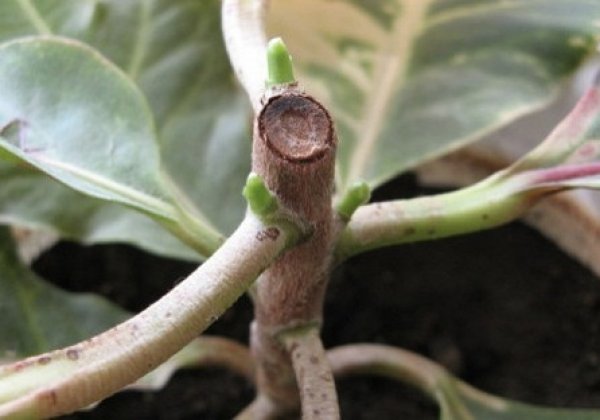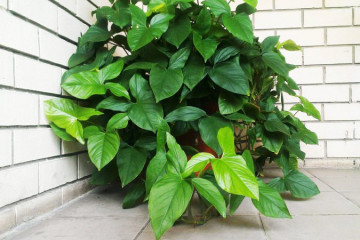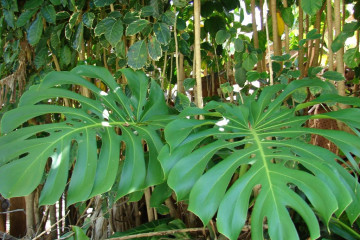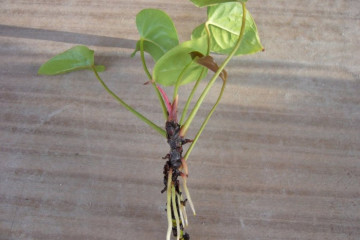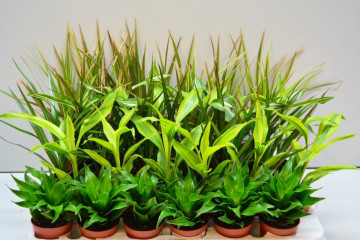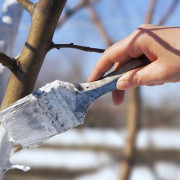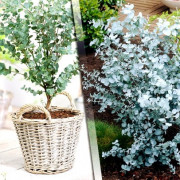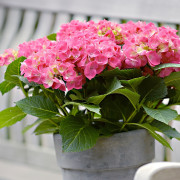Croton - reproduction at home
Content:
An unusual color of a plant can be in the form of a bush or even a tree. Croton, or codiaum, is loved for its bright leaves and color palette - from yellow to crimson-burgundy. The leaves have an interesting shape, dense and shiny, with bright veins that look like a drawing on the leaf.
Croton: breeding at home
At home, experienced breeders and flower growers are engaged in breeding this lover of warm islands. This exotic has a bad reputation due to its character. Florists need to know what croton loves and dislikes, how it multiplies, how it is cut off, what kind of soil is needed so that it grows fully. The plant requires a lot of attention:
- with a lack of light, it will lose the decorative color of its foliage;
- in the bright sun, the leaves get burned;
- drafts and temperature changes cause him to shed leaves;
- the soil should not dry out in the pot, and the moisture needed is 60%.
The tender croton multiplies in several ways, requires patience, since this flower itself does not grow too quickly. This exotic can be propagated by seeds, cuttings, leaves, air layers.
How to propagate croton by seeds
Croton seeds can be purchased at a flower shop, or you can collect them yourself. From the experience of breeders, to collect seeds of domestic crotons, you need to have two plants of both sexes and pollinate them. Seeds without such manipulations have poor germination, therefore this method is not successful.
Home-grown seeds retain their properties for a year. But it is better to sow them immediately after ripening. Before sowing, it is important to carry out treatment against fungi and infections, for example, with epin. It protects the seed from pests and diseases, and also promotes growth. Soak for two hours, and then immediately into the soil.
Lay the soil in layers - expanded clay, then earth (peat is possible), and sand on top. Sprinkle the seeds on top with sand and place in a warm place. Watering exclusively with a pallet method. Heating should also be from below, cover the pot on top with foil or glass, but ventilate every day.
After the first shoots, the time for airing should be gradually increased so that the sprouts get used to the natural growth conditions.
After a couple of days, it will be possible to evaluate the seeds for germination, as they wake up and begin to open. The first leaves will appear only after a month, after the third leaf you can plant the sprouts in separate pots. The cutting size of 10 cm will be no earlier than in 4 months.

Croton grows slowly and from the first days of the birth of life in a seed requires daily attention.
Leaves
If you tear off a croton leaf from the stem and put it in water or soil, it will take root. But the breeding process will stop there. A new shoot will not be released as it requires a bud.
Therefore, for the propagation of a leaf, a small part of the shoot and a bud are needed, from where new life will grow. The only difference from simple cuttings is that such a piece for propagation does not have to be the tip of the shoot. Using this method, several plants can be obtained from one cut cuttings.
Be sure to leave one leaf and a bud on the cut cuttings, the stem size is about 4-5 cm.Wipe off the secreted juice from both sides and let the stem dry for two hours. Then put in warm water, keeping the temperature until the roots appear at 25 degrees. If there are temperature fluctuations, the roots will not appear.
It is necessary to plant a sprout when the roots grow 3-5 cm in water.
How to propagate croton at home by cuttings
Cuttings already have a folded stem, in contrast to leaf propagation, where you need to wait for the awakening of the bud. The roots do not appear as quickly, but the plant will be stronger and stronger.
Step-by-step preparation of the cutting for planting:
- The cut must be done in one motion with a sharp knife.
- Treat the cut off place on the mother plant with charcoal, pruning will give an incentive to branch the shoot.
- On the cut cuttings, the cut site is washed with water and treated with charcoal.
- The stem should be exposed to air for two hours after cutting.
- We remove the lower leaves, and cut the upper ones in half, so that there is no expenditure of forces on these sheet plates.
- We place the cutting in a glass of water and maintain the water temperature at 25-27 degrees.
The stalk can be immediately rooted in a mixture of sand and peat in equal proportions. How to root a croton as comfortable as possible for him - in a package. A greenhouse made will accelerate growth and create the necessary moisture conditions. The flower, together with the pot, must be placed in a bag with holes for fresh air to enter.
Air layering
Reproduction of croton at home using air layers is most effective. This method may seem complicated at first glance. In fact, this is a quick way to get a strong and healthy plant, since all the forces for the development of the root system are taken from the mother flower. When the root system is fully formed, the flower painlessly transfers separation from the mother trunk and continues to actively grow foliage.
For rooting by air layers, an shoot is chosen that has already acquired a hard bark. An area two centimeters long must be exposed from the hardened crust with a sharp knife, but without harming the white center.
Treat the bare gap with a growth stimulant, wrap it with wet sphagnum moss and secure this air structure with a bag or film so that moisture inside the hanging pot remains. The top of the bag must be secured with the possibility of additional moisture during the growth process.

Roots will appear from the bare areas in a month, but you need to wait for their intensive growth so that the plant, after pruning, can continue to grow on its own
A more convenient way is to put a cut glass or a plastic bottle on the bare section of the trunk, securing it with tape or film. Fill the cups with peat and wait for the roots to appear.
Also, air layering can be obtained by digging the bare section of the trunk in the soil. To do this, you need to lower the shoot and fix it in the ground with a separate pot.
Adult transplant and toddler seating
After purchasing croton from the store, it is important to transplant it as soon as possible. An adult plant is transplanted once every 2-3 years. A young plant requires a change of soil every year. Cuttings with the appearance of roots up to 5 cm in length require rooting in a nutritious soil.
Substrate
The soil for croton needs loose and lightweight, since the plant does not like moisture, but will not tolerate stagnation of water in the soil. The earth must be nutritious. A good combination can be obtained by mixing in equal parts:
- humus;
- sod land;
- leafy ground;
- sand
- peat.
A universal substrate is also suitable, in which you will need to add a third of the sand.Before use, the soil must be treated with potassium permanganate and dried.
Pot
Croton is one of those plants that are busy growing roots in a large pot until they cover its entire area. Therefore, the pot should be small, no matter how strange it may look in comparison with the size of the bush growing from it.
The size of the pot should freely accommodate all the roots of the flower + 1 cm of free space around for the soil.
Clay and plastic pots are good for codiaum. The presence of a drainage hole is important, stagnant water is the cause of death.
After transplanting, it is necessary to place the pot in a warm place, maintain humidity and watering regime.
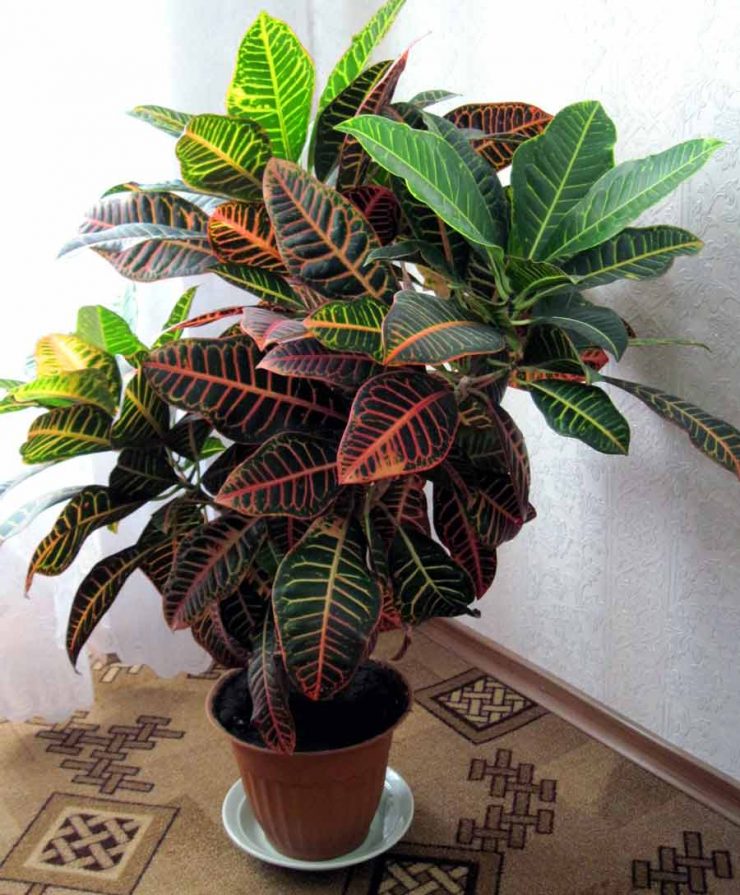
Croton transplant is difficult, therefore, during this period it is necessary to provide him with comfortable conditions as much as possible.
To the question of how to transplant a sick croton, the answer is quite obvious. Experienced flower lovers advise to cure it, and then transplant it.
How to trim croton to keep it fluffy
The handsome man grows in the form of a bush or tree, over time, on its shoots, old leaves dry and fall off, the shoots stretch out and lose their decorative effect. And the flower itself does not grow so actively and densely over the years. Pruning is done primarily to stimulate growth, acquire new forms of the bush, renew shoots and cuttings.
The formation of a full-fledged crown for this tree must be done by phased pruning:
- at 1.5 years, the plant is pinched to awaken the lateral buds and create new shoots;
- at 2 years old, pruning is done partially, regulating the growth of new shoots - adjusting the growth of shoots will help form a beautiful and desired crown shape;
- at the age of 5, a full-fledged pruning is performed: here the emphasis is not on the formation of the crown, but more on the stimulation of growth, since at this age the flower begins to slow down the growth processes.
Croton trimming should be done with a sharp, machined tool in one motion for each cut. Treat the cut sites with charcoal several times after the procedure. After pruning, let the plant rest, put it in partial shade, reduce watering.
Proper care of any plant guarantees a healthy and beautiful appearance. Croton will respond with gratitude with a palette of bright colors of its amazing leaves. It is important to approach the care of the plant with love in order to create warmth and comfort in the home.


